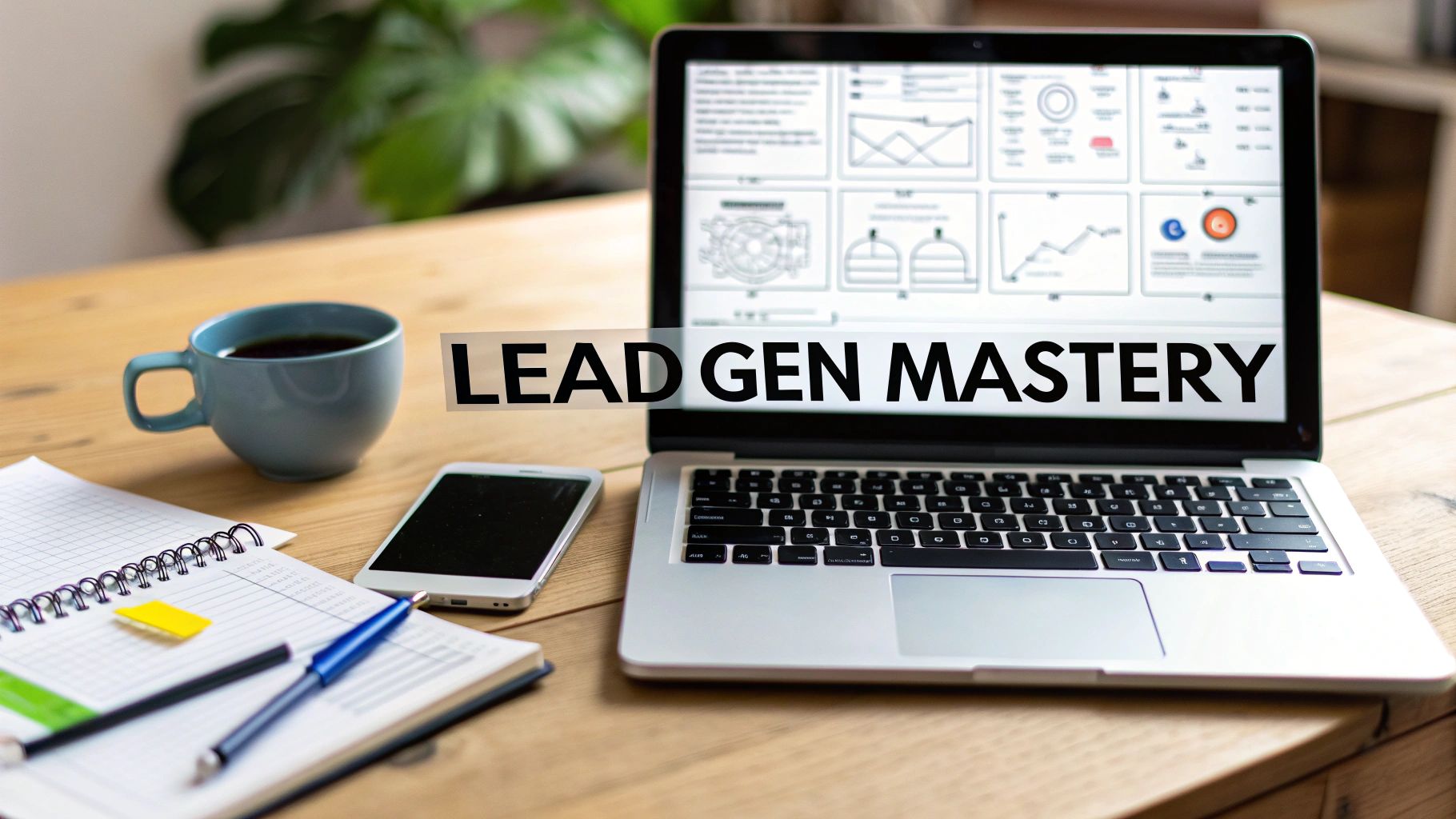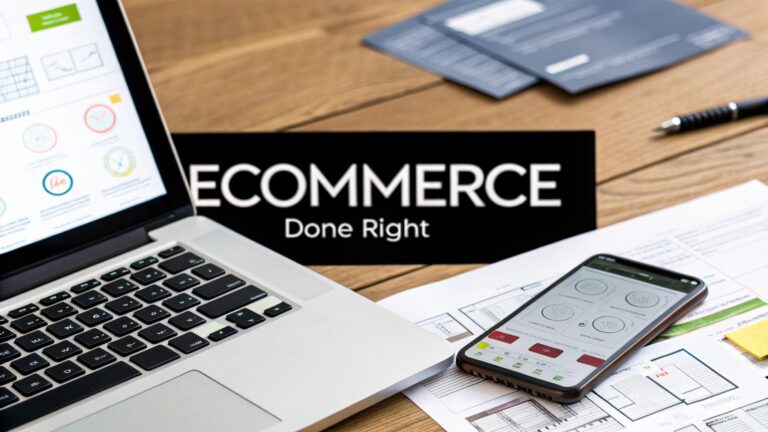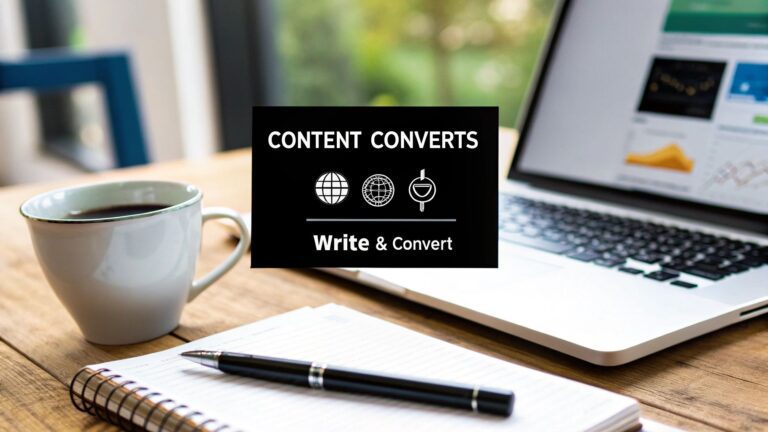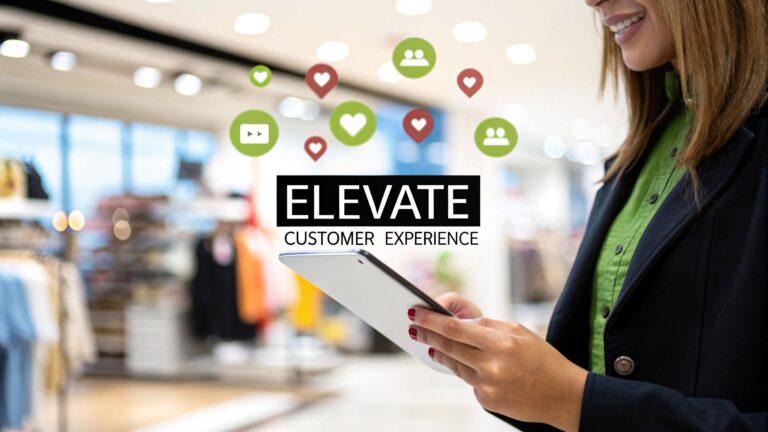Before you can win over a single customer, you need to know them inside and out. True lead generation for a small business isn't about spraying your message everywhere and hoping something sticks; it’s about crafting a powerful magnet that pulls the right people in. Getting this groundwork right ensures every pound you spend on marketing is aimed at people who are genuinely looking for what you offer.
Building Your Foundation for Lasting Leads

Diving into paid ads or social media without a plan is like setting sail without a map. You’ll certainly be busy, but you won't get anywhere meaningful. The real secret to sustainable growth lies in the prep work you do before you launch anything.
This means being brutally honest about who you're trying to reach. It goes deeper than just basic demographics. You need to understand their day-to-day problems, what truly motivates them, and even the exact words they use to talk about their frustrations. Nail this, and your marketing will stop feeling like an annoying interruption and start feeling like a welcome solution.
Define Your Ideal Customer Profile
Think of your Ideal Customer Profile (ICP) as a crystal-clear snapshot of your perfect customer. This isn't just some vague business school exercise; it's a practical tool that should guide every single marketing decision you make.
You don't need a massive budget to create one. Just look at your existing best customers—the ones you love working with.
- What sector are they in? (e.g., local hospitality, B2B services, retail)
- What’s their company size or who’s the key person? (e.g., sole trader, office manager, marketing lead)
- What specific headache do you cure for them? (e.g., saving them hours on admin, bringing more local shoppers through the door)
- Where do they spend their time online? (e.g., scrolling through LinkedIn, active in local Facebook groups, reading industry forums)
Answering these gives you a sharp focus. For instance, a Norfolk-based IT support company might define its ICP as: "Office managers at professional service firms with 10-50 employees in East Anglia who are fed up with slow, unreliable IT." That level of detail is marketing gold.
A well-defined ICP is your most powerful asset. It transforms your marketing from shouting into a crowded room to having a quiet, compelling conversation with someone who needs exactly what you have.
Map the Customer Journey
Once you know who you're talking to, you need to understand how they make a purchase. The customer journey is simply the path someone takes from vaguely hearing your name to happily handing over their money.
For most small businesses, this journey boils down to three main stages:
- Awareness: The person realises they have a problem. "Our website looks dated and isn't bringing in any enquiries."
- Consideration: They start looking for ways to fix it. This often means searching for things like "affordable web design for small business" or asking friends for recommendations.
- Decision: They weigh up their options and pick a provider, usually after comparing a few quotes and reading case studies.
When you understand this path, you can create content and offers that pop up at just the right moment for your prospects. This strategic approach is also incredibly cost-effective.
The table below shows the average Cost Per Lead (CPL) for UK businesses. As you can see, small businesses can acquire leads far more cheaply than large corporations, primarily because a targeted, organic approach works so well on a smaller scale.
Cost Per Lead (CPL) UK Business Size Comparison
| Business Size (Employees) | Average Cost Per Lead (CPL) |
|---|---|
| 2-50 | £38 – £47 |
| 51-200 | £75 – £96 |
| 201-1000 | £148 – £189 |
| 1000+ | £279 – £349 |
These figures really drive home the point: you don't need a massive budget, just a smart strategy. By focusing your efforts, you can achieve a CPL that big businesses can only dream of.
Your website is the hub of this entire journey. Having an affordable web design for small business that's built to convert visitors isn't just a nice-to-have; it's essential for capturing those valuable leads at every stage.
Attracting the Right Customers with Smart Digital Marketing
Once you have a crystal-clear picture of your ideal customer, you can finally stop shouting into the void and start showing up where they actually spend their time online. This isn't about just having a social media profile and hoping for the best. It's about a strategic, coordinated effort to bring genuinely interested people to your digital doorstep.
Think of it as a conversation. Your website, your content, and your social media presence should all work in concert, telling a consistent story that grabs attention and invites people in.
Get Found by Local Customers with SEO
For most small businesses, especially those serving a specific geographical area, Search Engine Optimisation (SEO) is an absolute game-changer. Let's be honest, when someone in your town needs a plumber, an accountant, or a great local café, their first move is almost always a quick Google search. Showing up at the top of that list is a massive advantage.
Local SEO is the art and science of optimising your online presence to capture those nearby searches. It’s how a tradesperson in Norwich can make sure they’re the first result when someone desperately searches for an "emergency electrician near me."
Here’s where to focus your energy:
- Your Google Business Profile is Non-Negotiable: Think of it as your digital shop front. It needs to be complete and kept up-to-date with your correct address, opening hours, services, and plenty of glowing reviews.
- Think Like a Local: Weave location-specific phrases into your website. Instead of just talking about "custom kitchens," you should be targeting "bespoke kitchen design in Suffolk."
- Get Your Details Straight: Make sure your business name, address, and phone number (NAP) are identical across all major online directories like Yell, Thomson Local, and any industry-specific sites. Consistency is key.
Nailing these fundamentals sends a powerful signal to Google that you are a relevant, trustworthy local expert. To really get a firm grip on this, our guide on 7 local SEO solutions you need to know about is a great next step.
Create Content That Actually Helps People
Content marketing is the fuel for your entire digital strategy. It’s all about creating and sharing genuinely useful, free information that pulls people in, turns them into customers, and keeps them coming back. The goal is simple: establish your expertise and build trust.
Stop writing about your services and start writing about your customers' problems. A B2B consultant targeting startups, for instance, could create a downloadable guide titled "The Startup's 10-Point Checklist for Surviving Year One." This hits a real pain point and offers a genuine solution, positioning them as a helpful expert, not just another salesperson.
Your content should answer the questions your ideal customers are typing into Google. When you become their go-to source for information, you'll be their first choice when they're ready to buy.
This approach creates a steady stream of what we call inbound leads—people who find you because you've already given them something of value. It's a long-game strategy, but it builds real, lasting connections.
Build Relationships on Social Media, Email, and SMS
While great SEO and content get you found, social media and email are where you nurture those budding relationships. It's no surprise that while 88% of UK businesses still rely on email, a massive 78% now use social media for lead generation. The shift towards direct, personal engagement is undeniable.
The trick is choosing the right playground. A highly visual business, like an interior designer, will do brilliantly on Instagram and Pinterest. A business coach, on the other hand, will find far more traction by sharing professional insights and joining conversations on LinkedIn. You have to be where your customers are, and your focus must always be on providing value, not just a constant sales pitch.
Don't overlook the power of direct communication either. For businesses serious about ramping up their lead-gen, exploring a complete SMS marketing playbook for small business growth can open up new possibilities. It’s a direct line to your audience that, when used respectfully, drives incredible engagement and immediate action.
Ultimately, authenticity wins. Share behind-the-scenes content, answer questions in the comments, and celebrate your customers' wins. This is how you build a community around your brand, turning passive followers into real leads and, eventually, your most passionate advocates.
Crafting Landing Pages That Actually Convert
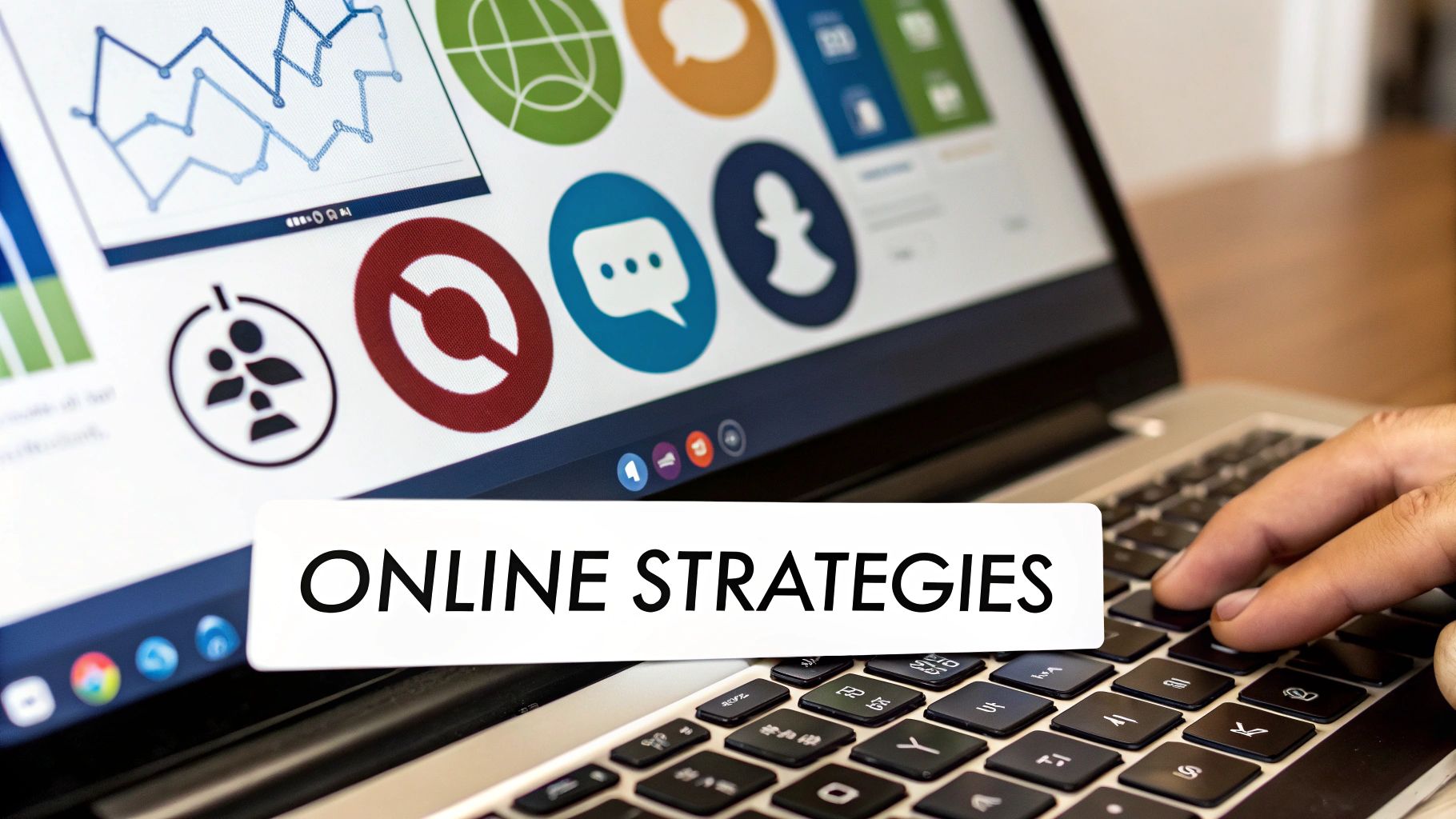
Getting traffic to your website is a great start, but it’s only half the story. The real challenge in lead generation for small businesses is converting those visitors into actual prospects. This is where a great landing page is worth its weight in gold.
A landing page isn’t just another page on your website; it's a specialist tool with a single, focused job: to capture a lead. Think of it as your most dedicated salesperson, delivering the perfect pitch every time. It needs to be clear, persuasive, and compelling enough for a visitor to decide, "Yes, I'll give you my contact details for that."
The Anatomy of a High-Converting Landing Page
So, what separates a landing page that works wonders from one that falls flat? It all comes down to a few critical elements working together seamlessly. When someone lands on your page, they should instantly understand your offer and know exactly what to do next.
The most effective pages I've seen all have these things in common:
- A Headline That Hooks: This is your first, and often only, shot to grab their attention. It needs to scream value. Instead of a bland "Download Our Checklist," try something like, "Get Our 15-Point Checklist to Double Your Local SEO Traffic." See the difference?
- Compelling Copy: Your words should speak directly to your visitor's problem and clearly position your offer as the solution. Use bullet points to break down the benefits, making them easy to scan and digest.
- Engaging Visuals: A relevant image, a quick explainer video, or even a well-designed graphic can do wonders for building trust and making your page more appealing.
- A Friction-Free Form: This is crucial. Only ask for the information you genuinely need. For a newsletter, an email is plenty. For a detailed B2B guide, you might ask for a name and company. Remember, every extra field you add is another reason for someone to leave.
A great landing page is relentlessly focused. It removes all distractions—like navigation menus or links to other parts of your site—to keep the visitor's attention squarely on the single action you want them to take.
Building Your Irresistible Lead Magnet
Let's be honest, people are protective of their email addresses. You can’t expect them to hand it over for nothing. You need to offer something genuinely valuable in return—this is your lead magnet. It’s a free resource that your ideal customer would be genuinely excited to get their hands on.
For a UK small business, getting specific and local is a winning strategy.
Real-World UK Examples:
| Business Type | Lead Magnet Idea | Why It Works |
|---|---|---|
| A Local Accountant | A "Guide to Claiming Business Expenses for UK Sole Traders" | Solves a real, pressing problem for their target audience with practical, timely advice. |
| A Personal Trainer | A "7-Day Home Workout Plan" PDF | Offers immediate value and a taste of their expertise without requiring a big commitment. |
| A Norfolk-based Caterer | A "Top 5 Summer Wedding Venues in Norfolk" Lookbook | Positions them as a local authority and connects with couples early in their planning process. |
The secret is creating something that solves a small but significant problem for your ideal customer. It shows off your expertise and kicks off a relationship built on value, not just a hard sell. A well-thought-out lead magnet makes filling out your form a no-brainer.
This is the blueprint for turning anonymous website visitors into a list of warm, interested prospects. It’s an essential part of any lead generation strategy, bridging the gap between attracting an audience and starting a real conversation. To make sure your pages are primed for success, I'd recommend digging into the top landing page design best practices for a deeper look at modern, effective design.
Turning New Leads into Loyal Customers
So, you’ve captured a new lead. That’s a fantastic first step, but it’s just the beginning of the journey. An email address sitting in your list doesn't pay the bills. The real work in lead generation for small businesses starts now, with the careful process of nurturing that initial interest into a lasting customer relationship.
This is all about building trust through consistent, valuable communication. You need to guide your new leads toward making a purchase, but without them ever feeling like they're getting a hard sell. It’s a delicate balance, achieved through thoughtful, strategic, and often automated, conversations.

Build Relationships with Email Sequences
One of the most reliable ways to nurture leads is with an automated email sequence, often called a drip campaign. This is simply a series of pre-written emails sent to new leads over a period of time. The immediate goal isn't to sell; it's to build trust and prove your worth.
A simple, effective sequence for a small business could look something like this:
- Email 1 (Sent Immediately): Deliver what they asked for! Get that lead magnet to them straight away. Keep it simple and focused on delivering that initial piece of value.
- Email 2 (2 Days Later): Follow up with a related, high-value piece of content. This could be a popular blog post or a quick 'how-to' video, reinforcing your expertise.
- Email 3 (4 Days Later): Share a customer success story or a brief case study. This is powerful social proof that shows you solve real-world problems for people just like them.
- Email 4 (7 Days Later): Now you can gently introduce your product or service as the logical solution to the problem you've been discussing.
This paced approach warms up your leads, making your offer feel like a natural and helpful next step when it finally arrives.
Personalise Your Message with Segmentation
Let's be honest: not all leads are the same. A prospect who downloaded your beginner's guide has very different needs from someone who asked for a detailed price list. Blasting the same generic message to everyone is a surefire way to get ignored. This is where segmentation comes into play.
Segmentation is the simple practice of dividing your email list into smaller, more focused groups based on shared traits or actions. For example, a Norfolk-based web design agency could segment its list by:
- The lead magnet downloaded: (e.g., "eCommerce Checklist" vs. "Local SEO Guide").
- Their industry: (e.g., hospitality vs. professional services).
- How engaged they are: (e.g., opened every email vs. opened none).
Segmenting allows you to send highly relevant content that speaks directly to each group's specific interests and challenges. It makes your communication dramatically more effective.
When you treat your leads like individuals instead of a faceless crowd, they are far more likely to listen. Personalisation shows you understand their specific challenges, building a foundation of trust that is essential for conversion.
Track Interactions with a Simple CRM
As your business grows, trying to track every lead interaction in a spreadsheet becomes a nightmare. A Customer Relationship Management (CRM) tool is essential for managing this process. Don't be intimidated by the term; many modern CRMs are designed specifically for small businesses and are incredibly straightforward.
A CRM acts as your central hub for all lead information and interactions. It lets you see:
- Who your leads are and how they found you.
- Which emails they’ve opened and which links they’ve clicked.
- Any notes from phone calls or meetings.
This information is gold. It helps you pinpoint your 'hottest' leads—the people who are most engaged and likely ready for a direct sales conversation. Knowing exactly when a lead has warmed up allows you to time your sales efforts perfectly, turning your lead nurturing from guesswork into a well-oiled machine.
To bring it all together, different situations call for different nurturing approaches. Here’s a quick comparison of some common strategies you can implement.
Lead Nurturing Strategy Comparison
| Nurturing Tactic | Best For | Example | Recommended Tool |
|---|---|---|---|
| Email Drip Campaign | Educating new leads over time and building general brand awareness. | A 4-part email series for new subscribers who downloaded a guide. | Mailchimp or MailerLite |
| Personalised Outreach | High-value leads who have shown strong buying intent (e.g., visited the pricing page). | A direct email from a founder referencing the lead's specific activity. | HubSpot CRM or Pipedrive |
| Retargeting Ads | Re-engaging leads who have visited your site but haven't converted yet. | A Facebook ad showing a testimonial to users who visited a specific service page. | Facebook Ads or Google Ads |
| Content Segmentation | Delivering highly relevant content based on a lead's interests or industry. | Sending an advanced "eCommerce Tax" guide only to leads in the retail segment. | Most email marketing platforms with tagging features. |
Choosing the right mix of these tactics will depend on your audience and your resources. The key is to stay in touch, provide value, and be there with the right message at the right time.
Measuring What Matters to Grow Your Business
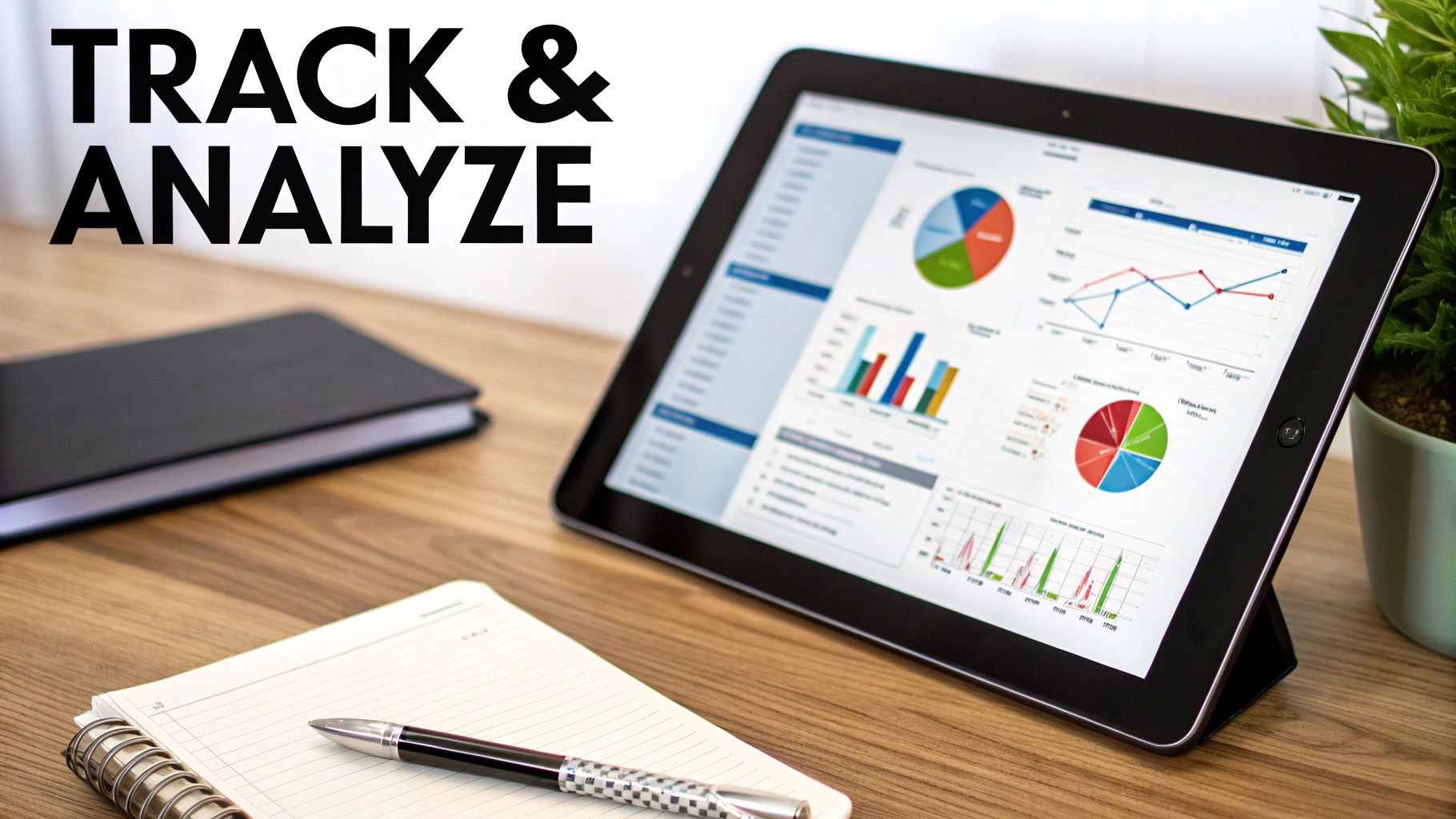
Pouring time and money into marketing without measuring the results is like driving with your eyes closed. You might be moving, but you have no idea if you’re actually heading in the right direction. To make your lead generation efforts truly count, you have to track what’s working and what isn’t.
This doesn't mean you need to become a data scientist overnight. The real secret is cutting through the noise and focusing on a handful of key performance indicators (KPIs) that tell the story of your business's health and growth. Honestly, this is what separates the businesses that thrive from those that merely survive.
Identifying Your Core Marketing Metrics
It’s incredibly easy to get lost in a sea of data. Instead of trying to track every metric under the sun, let's concentrate on the ones that have a real impact on your bottom line. For most small businesses I've worked with, these are the essentials.
- Conversion Rate: This is simply the percentage of visitors who take the action you want them to, like filling out your contact form or downloading a guide. A low conversion rate often points to a problem with your landing page or the offer itself.
- Cost Per Lead (CPL): This tells you exactly how much you're spending to get each new lead. You calculate it by dividing your total marketing spend by the number of new leads. If your CPL is consistently creeping up, that's a major red flag.
- Customer Lifetime Value (CLV): This is the total revenue you can realistically expect from a single customer over time. Knowing your CLV is crucial because it helps you figure out how much you can afford to spend on acquiring new leads while still making a profit.
Tracking just these three metrics gives you a surprisingly powerful, high-level view of your marketing performance. You'll understand not just how many leads you're getting, but also their quality and long-term value.
Measuring your marketing isn't about creating complicated reports. It's about gaining clarity. When you know your numbers, you can confidently double down on what works and cut what doesn't.
Using Google Analytics to Find Your Best Leads
You don't need expensive software to get started. Google Analytics is a free and incredibly powerful tool that can show you exactly where your best leads are coming from. Setting it up is pretty straightforward, and the insights you’ll get are invaluable.
The screenshot above shows a typical "Acquisition" report in Google Analytics, which is a fantastic place to start. This report breaks down your website traffic by its source—like "Organic Search" (from Google), "Direct" (people typing your URL), and "Referral" (clicks from other websites).
By digging into this report, you can see which channels aren't just sending you traffic, but which ones are sending visitors that actually convert. For example, you might discover that while Facebook sends a lot of visitors, the leads from your blog posts are far more likely to become paying customers. This is gold. It's the kind of information that tells you exactly where to focus your marketing budget.
Creating a Simple Review Process
Data is only useful if you act on it. I always advise clients to set aside a little time each month to review their core metrics and ask some straightforward questions. A monthly check-in is the perfect rhythm to start with.
- What worked? Pinpoint the channels or campaigns that brought in the highest-quality leads. Did that new blog series generate a spike in enquiries? Did sponsoring that local event actually pay off?
- What didn't work? Be honest about the efforts that fell flat. If a particular social media ad campaign had a sky-high CPL, it’s time to either radically change it or just switch it off.
- What will we do next? Based on what you've learned, make a clear plan for the month ahead. This could mean writing more content on a popular topic or shifting ad spend to your best-performing channel.
This simple review cycle creates a loop of continuous improvement. You make small, informed adjustments each month, gradually making your strategy more efficient and effective. This process is a cornerstone of a healthy business, and you can learn more about why digital marketing is important to boost your business in our related guide.
Your Top Lead Generation Questions Answered
Diving into lead generation can feel a bit overwhelming at first. There are a lot of moving parts, and it’s natural to have questions. In fact, questions are great—they show you’re thinking strategically about how to grow your business. Let’s tackle some of the most common queries we get from small business owners right here in the UK.
Which Lead Generation Channel Is Best?
This is a classic question, but there's no single "best" channel for everyone. The right answer comes down to one thing: where your ideal customers are.
Think about it this way. If you’re a B2B consultant offering specialist advice, you’ll probably find your best leads by joining professional conversations on LinkedIn. But if you run a local artisan bakery, your time is much better spent on visual platforms like Instagram and Facebook, where you can showcase your delicious creations to people in your neighbourhood.
It all goes back to your Ideal Customer Profile (ICP). Figure out where these people hang out online and what kind of content they engage with. That’s your starting point. This simple bit of research will save you a ton of time and wasted ad spend down the line.
How Much Should I Spend on Lead Generation?
Ah, the million-dollar question—or maybe the few-hundred-quid question for most small businesses. Instead of plucking a number out of thin air, a much smarter approach is to work backwards from your business goals.
First, get a handle on your Customer Lifetime Value (CLV). Let's say a typical customer spends about £1,500 with you over time. Knowing this gives you a clear idea of what you can afford to spend to get that customer in the door.
Next, look at your conversion rates. If you know that roughly one in every 20 leads turns into a paying customer, and you need five new customers this month, the maths is simple: you need to generate 100 leads.
Now you can build a sensible budget. If you find that a targeted Google Ad costs you around £5 per lead, your budget to hit that goal of 100 leads would be £500. Starting with data, even if it's just an initial estimate, is always better than guessing.
How Long Does It Take to See Results?
The timeline for getting results from lead generation for your small business can vary massively depending on the tactics you choose.
- Paid Advertising (like Google or Facebook Ads): This is your fast track. You can start seeing leads pop up within 24-48 hours of launching a campaign. It’s quick, but it requires a constant budget to keep the engine running.
- Search Engine Optimisation (SEO): Think of this as a long-term investment. You're looking at a 4-6 month runway before you see serious, consistent traffic. The upside? The leads are often higher quality and become more cost-effective over time.
- Content Marketing (like blogging): This works hand-in-hand with SEO and also builds momentum slowly. You might get a flicker of interest early on, but the real payoff comes after several months of consistently publishing genuinely helpful content.
Patience is key, especially with organic methods like SEO and content marketing. Paid ads can deliver those immediate wins, but organic channels build a valuable, long-term asset that will continue to bring in leads for years.
What Is the Difference Between a Lead and a Prospect?
People often throw these terms around as if they mean the same thing, but there’s a crucial difference that impacts how you manage your sales process.
A lead is simply someone who’s raised their hand to show a bit of interest. They might have downloaded your free guide or signed up for your newsletter in exchange for their contact details. They’re at the very top of your sales funnel.
A prospect, on the other hand, is a lead you’ve qualified. They fit your ideal customer profile, and they’ve probably shown more intent—maybe they visited your pricing page or asked for a demo. Your team has vetted them and decided they’re a potential customer worth actively pursuing.
In short, all prospects begin their journey as leads, but only a fraction of your leads will ever become genuine prospects.
Ready to stop guessing and start growing? At Ibertech Solutions Limited, we specialise in creating targeted web design and digital marketing strategies that turn visitors into valuable leads for businesses across Norfolk and Suffolk. Discover how we can build your lead generation engine today.


